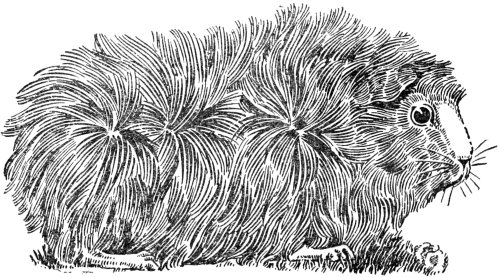Although many children may have at some point in their lives enjoyed their company as pets, little is known about Guinea Pigs and their natural behavior.
Guinea Pigs, Cavia porcellus, as you know are not actually pigs, but cavimorph rodents. Funnily enough though, mature males are called boars; females are sows and parturition is called farrowing, but offspring are called pups instead of piglets.

Their origins can be traced to the Andean highlands and in Quechua, a central highland tongue, they are called “quwe” or “cuy” as they are now more commonly known in the Andean highlands. Cavies, as they are sometimes called, derive their name from the taxonomic family Caviidae.
Cavies are more closely related to the capybara, chinchilla and porcupine, than to the mouse and rat (Gade, 1967). When they were domesticated is slightly obscure, but there is no doubt that they were first domesticated in the Andean ‘altiplano’ (highlands) of South America, roughly between 5000-7000 years ago. They were domesticated as an important source of food, as well as for religious and medical ceremonies.
One such medico-religious ceremony is Shoqma, an Andean ritual in which healers or “subadores” rub a live cuy over an afflicted person’s body, much in the manner of an X-ray or scanner. The little animal is then consulted either by watching its behavior, or alternately slitting the animal open, to read the diagnosis..
Guinea Pigs were extensively used as laboratory animals and used as subjects in countless experiments, and “guinea pig” is still used as a metaphor in English for subjects of clinical experimentation. The usage of guinea pigs as experimental subjects led to the discovery of Vitamin C in 1907, adrenaline, and the bacterium for tuberculosis: Mycobacterium tuberculosis (Robert Koch, 1882).

Linnaues (1758), was the first to classify the guinea pig, baptizing it with the scientific name; Mus porcellus. Pallas (1766), unaware of the earlier classification, did the same under the scientific name: Cavia cobaya. It is likely that Cavia porcellus derived from C. aparea, C. tschudii, or C. fulgida which share many common traits. In a gesture of sportsmanship, and taxonomic guidelines, a combination of both names Cavia porcellus was finally adopted and continues in use today.
As with horses, it is generally accepted that C. porcellus are no longer found living in a wild state, feral populations do exist. Much like horses, Guinea pigs are social herbivores that feed in groups with little competition for food (Harper, 1976).
In free living conditions, breeding units or family groups are usually comprised of a single male and 3-6 females and their offspring. Bachelor bands and multi-sex temporary bands are also common. These family units, or harem bands, live close to other breeding units and temporary assemblages. Unlike horses that live in herds, cavies live in colonies.
With poor eyesight Guinea pigs rely on well-developed senses, and communicate primarily through sounds and scent. They emit noises such as the wheek, chutt, squeak, purr and chirp, which likely convey information about an individual’s “state” to others. For example, a guinea pig “chutts” when exploring, “whistles” when separated from or reunited with a companion, and “purrs” when seeking contact (Harper 1976).
As expected in a social species, bonds are formed amongst individuals and communication is by way of vocalizations such as the “wheek” usually heard when visually separated from companions. They also “purr” when seeking or experiencing social contact. Urine and glandular secretions are also used to mark territories of up to 1500 m2. they also scent mark one another.
Guinea pig are a precocial species like horses. Their pups are born fully-furred, with well-developed sensory and locomotory abilities. They are able to consume solid food the same day they are born (Kunkele and Trillmich 1997) Females reach sexual maturity at two months of age; males reach it at three months (Nowak 1999).
Cavies are a prey species, so like horses, they are generally nervous of new sights, sounds and smells and have acute senses for detecting potential threats. Both species are cautious to approach novel stimuli, including conspecifics. They stretch out and contact the novel item or individual with their whiskers. This whisker first, extended body posture allows them to quickly flee if need be.
Unlike horses however, a perceived threat is immediately responded with a freeze or immobility response. Freezing is known to last up to 30 minutes in some occasions. When a group is startled, individuals flee haphazardly in what is known as the scatter response.
Guinea Pigs typically live in burrows. They are not agile diggers and don’t dig burrows themselves, but instead use burrows abandoned by other animals or natural formed shelters. Vegetation is collected and used as bedding.
Like horses, they need a high fiber diet based on grasses and hays, the abrasiveness of which help in wearing down their constantly growing teeth. Guinea Pigs, not horses, undergo a digestive process called caecotrophy, wherein special droppings, called caecotrophs are passed through the gut and pooped out and stored in the burrows as a source of food and fiber. These are later ingested to optimize foraging.
They remember learned pathways to and from food sources and other resources. The degree of spatial memory they are capable of needs further studies.
A quick look at the time budget of Guinea pigs in free living conditions, confirms that they usually spend up to 20 hours in a day active, and sleep only for short bouts at a time.






Very informative but a note to add to this is thay females can actually become pregnant from 4 weeks of age and males are ready to go from as early as 3 weeks. Not months